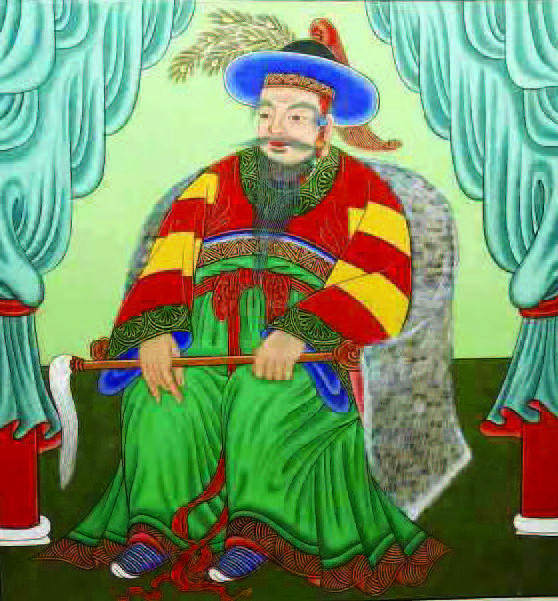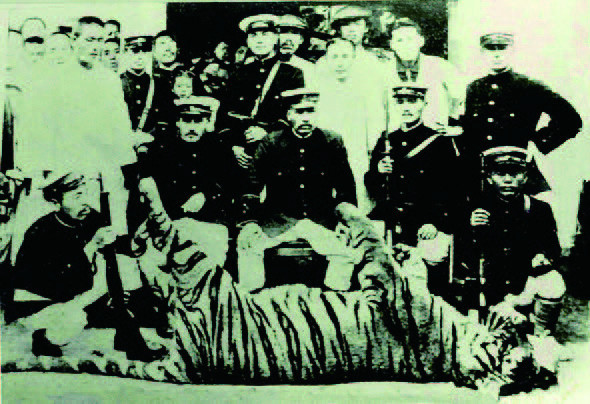GyeongGi Cultural Foundation
The Cheongnyangdang Shrine story and Tigers
The story of General Yi Hoe
"Stories on the Road" is a story about a UNESCO World Heritage site and a story. It will tell you the life and spirit of our ancestors in the ancient road of The old Namhansanseong path. |
Seonangdang and Jangseung

Seonangdang outside the south gate of Namhansanseong Fortress
“The patron saint of villages and travelers”
Seonangdang is a place to maintain old trees or build a pile of rocks to enshrine gods. Jangseung is a kind of a spiritual village guardian that people would erect at the entrance of their village to stop evil spirits and misfortunes that try to enter the area. Seonangdang was located at the peaks of mountain ridges, and tourists traveling on the old path would always have to pass over such ridges so it was inevitable for them to pass by a few seonangdang during their trip. Jangseung, which stood at the border of a village, was also frequently encountered by travelers, as the boundaries of a town were points where major roads and village paths meet. Bobusang and travelers who used the path always wished their trips to be safe, and seonangdang and jangseung were subjects to which they prayed for safety and wellbeing. In other words, seonangdang and jangseung were the patron saints and faith of not only the villages but also of the travelers.
The Cheongnyangdang Shrine story

(Left) Portrait of General Yi Hoe enshrined at Cheongnyangdang Shrine
(Right)Portrait of Mrs. Song also enshrined at Cheongnyangdang Shrine
“General Yi Hoe, the patron saint who protects the residents of Namhansanseong Fortress”
Cheongnyangdang Shrine is a place that enshrines General Yi Hoe, who is a special figure in the history of Namhansanseong Fortress, and the residents still revere him almost as a god. According to a myth, General Yi was falsely accused of misusing construction expenses while building the southern wall of the fortress and was eventually beheaded in front of the Seojangdae command post of Namhansanseong Fortress. Mrs. Song went around many places to collect clemency donations, but when she heard of her husband’s death she lamented ceaselessly before throwing all of the rice as well as herself into a river. Later, the government dispatched officials for an investigation, which eventually revealed that the southern walls constructed by General Yi were incomplete but extremely sturdy. The interesting thing here is that the myth of General Yi has been recreated by fusing fact and fiction. The story of a false accusation and eventual execution despite remarkable efforts in construction of the fortress brought great sympathy from the people who also took part in building the fortress, and he became a subject of divinity and a patron saint that protects the village of those who helped to build Namhansanseong Fortress.
Tigers

The last tiger of the Korean Peninsula, murdered by a Japanese policeman / 1922
“Where is the tiger now that used to protect the shrine of General Yi Hoe?”
Tigers have been treated as friendly animals and mystical creatures by our people. In the tale of the “Tiger guiding the road” of Sanseong-ri, the tiger guides the villagers who have lost their way to the shrine of General Yi Hoe like a tiger god protecting the town at the side of a mountain spirit. As you can see, our people have both feared and loved tigers. However, tigers, the subject of our people’s long-time love and reverence, went extinct in an instant. The Japanese colonial government carried out a full-fledged overhunting of large carnivores inhabiting the Korean Peninsula under the purpose of “saving hazardous animals that harm humans”. From 1915 to 1942, the Japanese captured large carnivores such as tigers, leopards, and wolves by dispatching tens of thousands of hunters every year, which led to the eventual extinction of tigers on the Korean Peninsula. Reports of tiger sightings by residents of Namhansanseong Fortress and the neighboring areas also stopped around this time.
<Copyright(c)2002 GGC All rights reserved.>
information
Stories on the Road
Published by/ Namhansanseong World Heritage Centre, Gyeonggi-do The Center for Gyeonggi Studies, Gyeonggi Cultural Foundation
Published on/ November 24, 2017
Supervised by/ Lee Ji-hoon, Director of the Center for Gyeonggi Studies, Gyeonggi Cultural Foundation
Planned and coordinated by/ Chae Chi-yong, Senior Researcher at the Center for Gyeonggi Studies, Gyeonggi Cultural Foundation Park Da-seul, Researcher at the Center for Gyeonggi Studies, Gyeonggi Cultural Foundation
keywords
- Writer
- GyeongGi Cultural Foundation
- About
- Everything about the GyeongGi arts and culture, GGCF
- homepage
- http://www.ggcf.kr